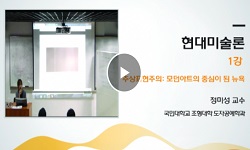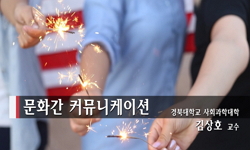This paper examines the psychoanalytic reinterpretation on Minimalism performed by Georges Didi-Huberman in Ce que nous voyons, ce qui nous regarde (1992). In the history of art, as a ‘specific’ object, Minimalism has been evaluated as an essence ...
http://chineseinput.net/에서 pinyin(병음)방식으로 중국어를 변환할 수 있습니다.
변환된 중국어를 복사하여 사용하시면 됩니다.
- 中文 을 입력하시려면 zhongwen을 입력하시고 space를누르시면됩니다.
- 北京 을 입력하시려면 beijing을 입력하시고 space를 누르시면 됩니다.

징후의 오브제 : 미니멀리즘에 대한 정신분석적 재해석 = Object as Symptom: Psychoanalytic Reinterpretation on Minimalism
한글로보기https://www.riss.kr/link?id=A107773988
- 저자
- 발행기관
- 학술지명
- 권호사항
-
발행연도
2021
-
작성언어
-
-
주제어
디디 위베르만 ; 프로이트 ; 라캉 ; 징후 ; 미니멀리즘 ; Georges Didi-Huberman ; Sigmund Freud ; Jacques Lacan ; Symptom ; Minimalism
-
KDC
100
-
등재정보
KCI등재
-
자료형태
학술저널
-
수록면
1-33(33쪽)
-
KCI 피인용횟수
0
- DOI식별코드
- 제공처
- 소장기관
-
0
상세조회 -
0
다운로드
부가정보
다국어 초록 (Multilingual Abstract)
This paper examines the psychoanalytic reinterpretation on Minimalism performed by Georges Didi-Huberman in Ce que nous voyons, ce qui nous regarde (1992). In the history of art, as a ‘specific’ object, Minimalism has been evaluated as an essence of Modernism or a break of Modernism which initiated post-modern art. Simultaneously, as Michael Fried pointed out, in the mode of exhibition, this specific object turned out to be a non-specific object whose meaning disperses infinitely according to the relationship among the work, the spectator, and the real space-time in which the work and the spectator co-exists. Didi-Huberman escapes from this binary choice between the specificity or the non-specificity and reinterprets Minimalism object as an object of symptom. Didi-Huberman not only indicates the ambiguous status of Minimalism in the history of art but also describes the source of that ambiguity based on the very form and materiality of Minimalism object. Minimalism object is nor reduced as a visible explicitness nor dispersed to the infinite significance. As a dialectic image, Minimalism object works as the Freudien symptom of inquietude reminding us the inevitable invisibility imposed on our seeing. In the dialectic of the visual, Didi-Huberman discovers the alternative psychoanalytic image theory which does not reduce the image to a linguistic signifier or privilege the phenomenological shock effect of the Lacanian real.
참고문헌 (Reference)
1 이나라, "죽음의 오브제, 죽음의 장소: 르네상스, 미니멀리즘, 김민애" 75 : 144-149-144, 2018
2 이나라, "조르주 디디 위베르만의 이미지론에서 부재의 형상: 프라 안젤리코, 미니멀리즘, 제임스 터렐 비평의 경우" 현대미술사학회 (45) : 65-91, 2019
3 지그문트 프로이트, "정신분석학의 근본 개념" 열린책들 2017
4 이지은, "미니멀리즘의 인간형태주의 논쟁" 미술사학연구회 (24) : 177-206, 2005
5 김진엽, "미니멀리즘" 한국미학회 (32) : 227-253, 2002
6 조르주 디디 위베르만, "모든 것을 무릅쓴 이미지들" 레베카 2017
7 Lacan, Jacques, "Écrits" Seuil 1966
8 Greenberg, Clement, "The Collected Essays and Criticism" University of Chicago 1993
9 Larsson, Chari, "Suspicious Images: Iconophobia and the Ethical Gaze" 15 (15): 2012
10 Krauss, Rosalind, "Passages in Modern Sculpture" The MIT Press 1977
1 이나라, "죽음의 오브제, 죽음의 장소: 르네상스, 미니멀리즘, 김민애" 75 : 144-149-144, 2018
2 이나라, "조르주 디디 위베르만의 이미지론에서 부재의 형상: 프라 안젤리코, 미니멀리즘, 제임스 터렐 비평의 경우" 현대미술사학회 (45) : 65-91, 2019
3 지그문트 프로이트, "정신분석학의 근본 개념" 열린책들 2017
4 이지은, "미니멀리즘의 인간형태주의 논쟁" 미술사학연구회 (24) : 177-206, 2005
5 김진엽, "미니멀리즘" 한국미학회 (32) : 227-253, 2002
6 조르주 디디 위베르만, "모든 것을 무릅쓴 이미지들" 레베카 2017
7 Lacan, Jacques, "Écrits" Seuil 1966
8 Greenberg, Clement, "The Collected Essays and Criticism" University of Chicago 1993
9 Larsson, Chari, "Suspicious Images: Iconophobia and the Ethical Gaze" 15 (15): 2012
10 Krauss, Rosalind, "Passages in Modern Sculpture" The MIT Press 1977
11 Battcock, Gregory, "Minimal Art: A Critical Anthology" University of California Press 1968
12 Lacan, Jacques, "Le Séminaire Ⅺ, Les quatre concepts fondamentaux de la psychanalyse" Seuil 1964
13 Freud, Sigmund, "Gesammelte Werke Ⅱ/Ⅲ" S. Fischer Verlag 1942
14 Didi-Huberman, Georges, "Fra Angelico: Dissemblance et figuration" Flammarion 1995
15 Larsson, Chari, "Didi-Huberman and the Image" Menchester University Press 2020
16 Didi-Huberman, Georges, "Devant le temps" Les Éditions de Minuit 2000
17 Morris, Robert, "Continuous Project Altered Daily: The Writings of Robert Morris" The MIT Press 1993
18 Judd, Donald, "Complete Writings 1959-1975" The Press of the Nova Scotia College of Art and Design 1975
19 Didi-Huberman, Georges, "Ce que nous voyons, ce qui nous regarde" Les Éditions de Minuit 1992
20 Fried, Michael, "Art and Objecthood: Essays and Reviews" University of Chicago Press 1998
21 Fried, Michael, "Absorption and Theatricality: Painting and Beholder in the Age of Diderot" University of California Press 1980
동일학술지(권/호) 다른 논문
-
니체 죽음론의 현대적 전유를 위한 예비연구 : 하이데거의 니체 이해에 대한 비판적 고찰을 통하여
- 한국미학회
- 오윤정 ( Oh Yoonjung )
- 2021
- KCI등재
-
- 한국미학회
- 정혜윤 ( Chung Hye-yoon )
- 2021
- KCI등재
-
고통스러운 예술의 역설 : 스트롤의 부사구주의 쾌 이론과 강한 양가성
- 한국미학회
- 최근홍 ( Choi Kunhong )
- 2021
- KCI등재
-
헤겔의 ‘화해’ 규정을 통해 본 근대예술 : 장르화에서 객관적 유머까지
- 한국미학회
- 홍혜선 ( Hong Hyeseon )
- 2021
- KCI등재
분석정보
인용정보 인용지수 설명보기
학술지 이력
| 연월일 | 이력구분 | 이력상세 | 등재구분 |
|---|---|---|---|
| 2027 | 평가예정 | 재인증평가 신청대상 (재인증) | |
| 2021-01-01 | 평가 | 등재학술지 유지 (재인증) |  |
| 2018-01-01 | 평가 | 등재학술지 유지 (등재유지) |  |
| 2015-01-01 | 평가 | 등재학술지 유지 (등재유지) |  |
| 2011-01-01 | 평가 | 등재학술지 유지 (등재유지) |  |
| 2009-01-01 | 평가 | 등재학술지 유지 (등재유지) |  |
| 2006-01-01 | 평가 | 등재학술지 선정 (등재후보2차) |  |
| 2005-06-17 | 학술지등록 | 한글명 : 미학외국어명 : The Korean Journal of Aesthetics |  |
| 2005-01-01 | 평가 | 등재후보 1차 PASS (등재후보1차) |  |
| 2004-01-01 | 평가 | 등재후보 1차 FAIL (등재후보2차) |  |
| 2003-01-01 | 평가 | 등재후보 1차 PASS (등재후보1차) |  |
| 2002-01-01 | 평가 | 등재후보학술지 유지 (등재후보1차) |  |
| 1999-07-01 | 평가 | 등재후보학술지 선정 (신규평가) |  |
학술지 인용정보
| 기준연도 | WOS-KCI 통합IF(2년) | KCIF(2년) | KCIF(3년) |
|---|---|---|---|
| 2016 | 0.45 | 0.45 | 0.43 |
| KCIF(4년) | KCIF(5년) | 중심성지수(3년) | 즉시성지수 |
| 0.45 | 0.45 | 1.026 | 0.2 |




 KCI
KCI KISS
KISS







